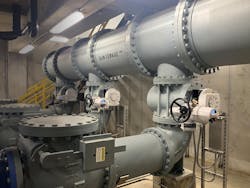Rotork provides control of flow at water resource recovery facility
Rotork IQT part-turn electric actuators have been specified for use at the Water Resource Recovery Facility (WRRF) in East Lansing, Michigan. This activated sludge/tertiary filtration plant has the capacity to process approximately 18.75 million gallons of water every single day and provides wastewater treatment for the City of East Lansing, Michigan State University and the Meridian Charter Township.
Over 100 actuators have been ordered, consisting of various IQ3 and IQT3 range part-turn electric actuators, including the IQ18, IQ25, IQT-125, 500, 1000 and 2000. These actuators serve a variety of vital roles, including the operation of flow control valves, sluice gates, ball control valves, AWWA butterfly valves and eccentric plug valves. They were installed alongside IW Mk2 quarter-turn worm gearboxes.
The actuators are able to accurately control the exact amount of flow. Going beyond simple open/close functions, they can move the valves and gates to exact positions to provide complete control of flow in the process. In addition to this modulating service, the actuators also provide an isolating service in a new digester process. The digester process breaks down the waste material to produce biogas and the actuators ensure that the flow of municipal wastewater can be stopped, should it be necessary to do so.
These new installations were not the first Rotork actuators on site. With an installed base of IQTs connected through DeviceNet and an additional installation of around 50 IQ3 intelligent integral non-intrusive electric actuators and IQTs in 2016, Rotork has a strong presence at East Lansing WRRF and it is expected to grow with future developments with the assistance of agent Systems Specialties.
